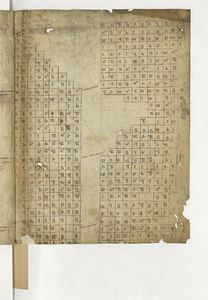Difference between revisions of "Table arithmétique – Fragment"
Jump to navigation
Jump to search
(created page) |
(added links to jpegs) |
||
| Line 1: | Line 1: | ||
Notes on the numerical tables of [https://fragmentarium.ms/overview/F-cfux Table arithmétique (Fragment)], Latin 9377, f. 113<ref>Note that both "9377" and "113" are prime. Coincidence?</ref> in the [https://www.bnf.fr/fr Bibliothèque nationale de France (Paris)]. | Notes on the numerical tables of [https://fragmentarium.ms/overview/F-cfux Table arithmétique (Fragment)], Latin 9377, f. 113<ref>Note that both "9377" and "113" are prime. Coincidence?</ref> in the [https://www.bnf.fr/fr Bibliothèque nationale de France (Paris)]. | ||
| + | |||
| + | <gallery mode="traditional" widths=300px heights=300px> | ||
| + | fragmentarium_Latin_9377_f113_left.jpg|Left side of Latin 9377 f.113 | ||
| + | fragmentarium_Latin_9377_f113_right.jpg|Right side of Latin 9377 f.113 | ||
| + | </gallery> | ||
==Description of Fragment== | ==Description of Fragment== | ||
Revision as of 19:46, 24 October 2020
Notes on the numerical tables of Table arithmétique (Fragment), Latin 9377, f. 113[1] in the Bibliothèque nationale de France (Paris).
Description of Fragment
The fragment consists of a single sheet of parchment, folded in half, with numerical tables written on both the left and right sides of the inside (flesh-side) of the parchment.
A fascimile of the pages can be viewed at [1]:
outside (reverse of left side)
outside (reverse of right side)
On the left side are 2 columns, each with 3 tables (and each with a cut off table at the bottom. On the right side are 2 columns each with 1 continuous table.
The Tables
Background
The numbers are "apices" of early Arabic numbers.
in a table from "Histoire de la Mathematique" by J.E. Montucla, published in 1757
- ↑ Note that both "9377" and "113" are prime. Coincidence?

